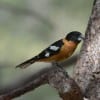 By Jim Stevenson
By Jim Stevenson
I am trying to decide whether to schedule one or two California and/or Australia birding trips next summer. Please let me know if there is a reasonable chance you could go. Not necessarily a commitment! California, two weeks, $3000, month of June. One would be first two weeks, second would be second half of June. Australia, two weeks, $3500, limited to five people, month of July (their cool season). Who is INTERESTED, and please specify which one? Note: There will be NO Great Plains or Alaska trip next year, but will resume in 2015.
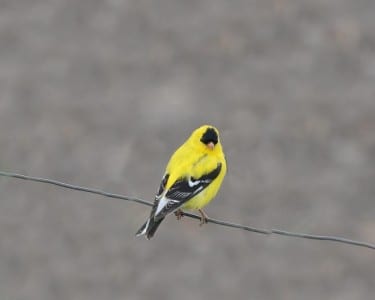
Birds with a conical bill (no, not Barnacle Bill) crack seeds, and are represented by New and Old World finches. We have quite a few of the latter, having migrated here during one of the recent Pleistocene Glaciations. If memory serves, finches with split (forked) tails are of Old World (Asian) origin, while squared-off tails evolved in the New World. These American Goldfinches are widespread in North America but many southerners only see them in their relatively drab winter plumage. These males in alternate plumage are real lookers and delight folks up North with feeders. In California thereare also Lesser and European Goldfinches, quite a variety for one state.
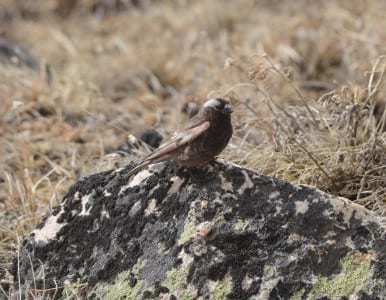
Breeding high in the western mountains are 3-4 species of birds called rosy-finches, with this being my favorite, the Black Rosy-finch. I find them easily on the Plains-Rockies trip at Beartooth Pass, nearly 12,000 feet (right out the window). They blend right in with the lichen, and with that kind of cryptic coloration, it’s hard to take that for granite. BTW, in the winter, all three (soon to be four?) species can be seen right out the window in the mountains near Albuquerque, although I found the facility closed this May.
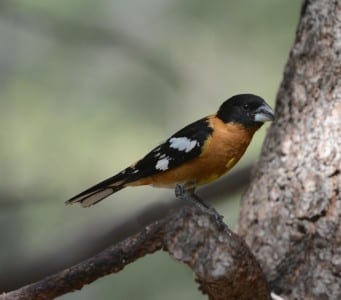
The squared-off tail of this Black-headed Grosbeak demonstrates a New World origin, and I can’t think of any grosbeaks that came from Asia. Some buntings, yes. Anyway, this species is very common out West, easily lured to seed feeders and nearly as tame as its sister species, the Rose-breasted of the East. It’s always been interesting to me how many of these may be heard singing on the old John Wayne movies. Beats the acting.
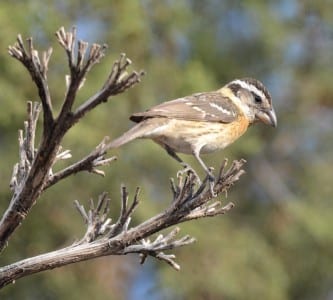
Many ofthe colorful (male) finches havecamouflaged females that mind the nest while hubby sings and grabs groceries. My friends in Texas should always be on the lookout for this species, and most of the records are females (or likely some immatures). Some of their calls also sound very much like our eastern bird. Go ahead; look em up! 😉 There are more “eastern” birds than you might think out West, like this Blue Grosbeak, and even RBGBs in Montana. These blue gems are easily told by the reddish wingbars, large bill, “tink” call note and they even wag their tail. These clearly prefer open country and show up on the UTC in the latter half of both migrations, on bushes and barbed wire fences. Alice Ann’s neighborhood is great for them.
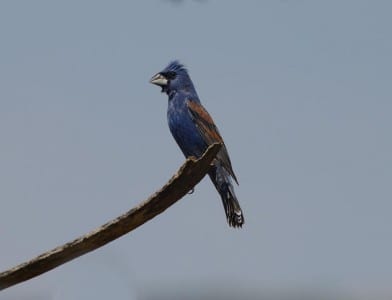
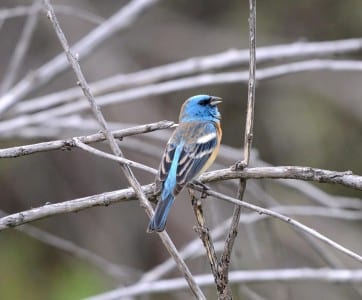
Lazuli Buntings are the western counterpart to the Indigo of the East. They have bluebird red on the chest buttheir song and bill are definitely that of a finch. Out West they seem to have an affinity for water, even nesting near mountain streams. Female buntings of several species are nearly indistinguishable brown, with us thanking Heaven for the female Painted Buntings and their green coloration.
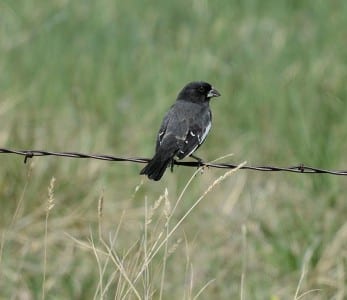
Lazuli Buntings are the western counterpart to the Indigo of the East. They have bluebird red on the chest buttheir song and bill are definitely that of a finch. Out West they seem to have an affinity for water, even nesting near mountain streams. Female buntings of several species are nearly indistinguishable brown, with us thanking Heaven for the female Painted Buntings and their green coloration.
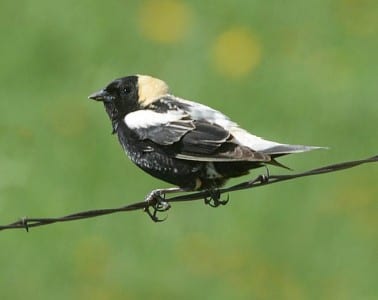
Lazuli Buntings are the western counterpart to the Indigo of the East. They have bluebird red on the chest buttheir song and bill are definitely that of a finch. Out West they seem to have an affinity for water, even nesting near mountain streams. Female buntings of several species are nearly indistinguishable brown, with us thanking Heaven for the female Painted Buntings and their green coloration.
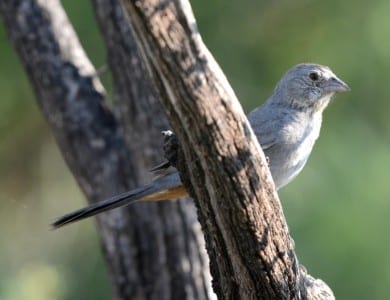
Towhees are a smallgroup of ground-dwelling birds most closely related to sparrows. They are named for their call, but some do better “tow-hees” than other species. This is the Canyon Towhee, the eastern half of the old “Brown” towhee that wassplit. Like catbirds and a few others, this gray bird has reddish-brown undertail coverts. They are more common in drier areas while the next species prefers forests with more rainfall.
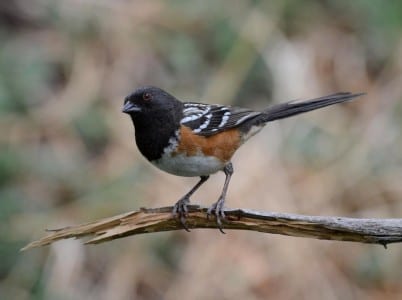
Obviously, Spotted Towhees are closely related to the Eastern Towhee of my Florida childhood. In fact, they were once considered the same species, so birders have gotten a gain of two species in my lifetime (the last 400 years). In Alabama, where my parents grew up, some areas called the towhee a “chewink,” no doubt on account of their call. In these two closely-related species, female have brown where the males have black.
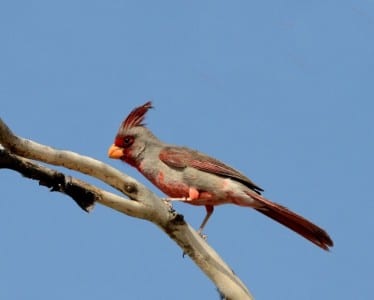
Looking like a suped-up cardinal, the Pyrrhuloxia is fairly common in the Desert Southwest. Their name refers to their “hair” being like fire, and in this year’s desert heat, that’s possible. Occasionally, one shows up back East, but more likely, another young cardinal gets called a Pyrrhuloxia.
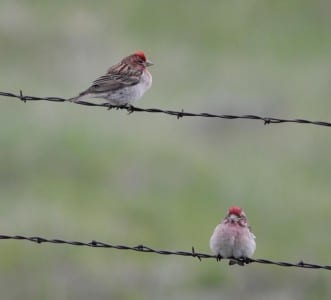
There are several finches with reddish coloration, with this Cassin’s Finch being the more common in western mountains. These two are males, but females are much tougher to tell from Purple and House Finches. Any such finch seen in the Houston/Galveston area is almost surely a House Finch, as Purples continue to get harder and harder to see this far south. This is true for a number of other wintering birds.
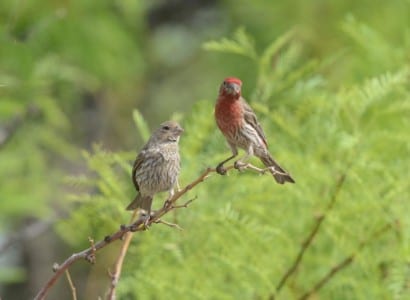
House Finches are doing just fine and seem to be spreadingin the Houston area. They are quite common in the Desert Southwest, especially at seed feeders. You can see how the male differs from the Cassin’s on the previous page, and a few of their numbers are more yellow than red. Beginners, don’t confuse these with House Sparrows.
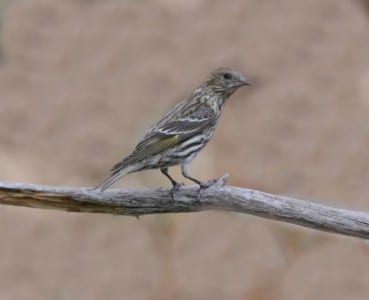
Pine Siskins have become scarce as well in the wintertime Houston area but out West, they are doing just fine (where they breed). They are really just a small, streaked finch with conspicuous yellow patches in their wings. They are more often associated with conifers than broad-leafs, and as common fly-overs, learning their call notes is crucial.
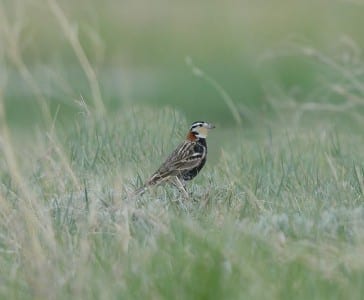
Longspurs are a group of four sparrow-like birds with bright colors and white feathers in the tail. This is the Chestnut-collared Longspur, fairly common in parts ofMontana where we bird. The males drop down on small, open areas after serenading the females from the air. Many grassland birds sing from their air. We also photographed McCown’s Longspur but my pictures were pretty crappy.

 Posted in
Posted in 

























Once your device has been jailbroken, you can begin the unlocking process using another software program.
The race is on to get the hottest new iphone downloads you can find.
JailbreakMe works with the iOS 3.1.2 or later.